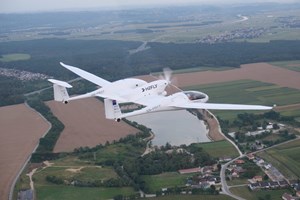News
H2FLY and partners complete piloted flight of liquid H2-powered electric aircraft
H2FLY, the Stuttgart, Germany-based developer of H2-electric powertrain systems for aircraft, completed a piloted flight of an electric aircraft powered by liquid H2. The H2FLY team has completed four flights powered by liquid H2 as part of its flight test campaign, including one flight that lasted for over three hours. The flights were completed with H2FLY’s piloted HY4 demonstrator aircraft, fitted with a H2-electric fuel cell propulsion system and cryogenically stored liquid H2 that powered the aircraft.
Results of the test flights indicate that using liquid H2 in place of gaseous H2 will double the maximum range of the HY4 aircraft from 750 km to 1,500 km, marking a critical step towards the delivery of emissions-free, medium- and long-haul commercial flights.
“This achievement marks a watershed moment in the use of H2 to power aircraft. Together with our partners, we have demonstrated the viability of liquid H2 to support medium and long-range emissions-free flight,” said Professor Josef Kallo, co-founder of H2FLY. “We are now looking ahead to scaling up our technology for regional aircraft and other applications, beginning the critical mission of decarbonizing commercial aviation.”
The successful campaign marks a significant milestone for H2FLY, reflecting the extensive insights from the company’s research efforts. Moreover, it is the culmination of Project HEAVEN, a European-government-supported consortium assembled to demonstrate the feasibility of using liquid, cryogenic H2 in aircraft. The consortium is led by H2FLY and includes the partners Air Liquide, Pipistrel Vertical Solutions, the German Aerospace Center (DLR), EKPO Fuel Cell Technologies, and Fundación Ayesa.
Beside project HEAVEN, the work has been funded by the German Federal Ministry for Economic Affairs and Climate Action (BMWK), the German Federal Ministry for Digital and Transport (BMVD), and The University of Ulm. Compared with pressurized gaseous H2 storage (GH2), the use of liquified, cryogenic H2 (LH2) enables significantly lower tank weights and volume, therefore leading to increased aircraft range and useful payload.
Pierre Crespi, Innovation Director at Air Liquide Advanced Technologies said, “Air Liquide is proud to have designed, manufactured and integrated, together with H2FLY, the liquid H2 tank that enabled to power the HY4 aircraft. Today’s success demonstrates the full potential of liquid H2 for aviation. Liquid H2 can be stored onboard and transported. H2 is key to the energy transition and this new step proves that it’s already becoming a reality.”
Tine Tomažič, head of engineering and programs at Pipistrel said, “To be a part of this magnificent team has been an honor. At Pipistrel, our aim is to be the pioneer of future flight and playing a role on the liquid H2 tank integration, we, along with all the other partners involved, are able to demonstrate the success of alternative sustainable fuels, ready to power the aircraft of tomorrow.”
Dr. Syed Asif Ansar, Head of Department Energy System Integration at the German Aerospace Center (DLR) said, “DLR boasts extensive expertise in electrified aircrafts, with a track record spanning over 15 years. Starting from the inaugural flight of the Antares DLR-H2 in 2009, consistent advancements have been made in fuel cells and their auxiliary systems. This progressive journey culminates in a significant present achievement in aviation history: the utilization of cryogenic liquified H2 as fuel storage for a four-seater aircraft powered by fuel cells. Collaborating with H2FLY, AirLiquide and other project members, DLR is actively engaged in projects aimed at propelling the development of CS-23 and CS-25 fuel cell powered aircraft into the next phase.”
With the completion of the flight testing in project HEAVEN, H2FLY will focus on the path to commercialization. In June, H2FLY announced the development of its new H2F-175 fuel cell systems which will be capable of providing their full power range in flight altitudes of up to 27,000 ft, marking an important step on the path from lower altitude viability flight demonstrations to real-world commercial aircraft applications.
In 2024, H2FLY will open its H2 Aviation Center at Stuttgart Airport, co-funded by the Ministry of Transport Baden Württemberg. The center will become a focal point for the future of Europe’s aviation industry and its H2 economy, providing fuel cell aircraft integration facilities and liquid H2 infrastructure.


